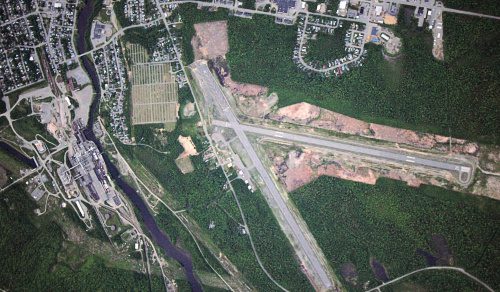Winter weather in central Maine has changed significantly over the last few decades, prompting Millinocket Municipal Airport (MLT) to update its snow removal equipment to meet the new airfield maintenance challenges.
Winter weather in central Maine has changed significantly over the last few decades, prompting Millinocket Municipal Airport (MLT) to update its snow removal equipment to meet the new airfield maintenance challenges.
 In the past, local snow was light and powdery, which allowed Airport Manager Jeff Campbell to use a 1994 Dresser bucket loader equipped with a self-powered Blanchet snowblower of the same vintage to clear MLT’s 4,713-foot east/west runway (11-29). But over the years, winter storms morphed into a mixture of snow and rain, and the airport’s self-powered, single-stage snowblower was often unable to move the heavy, wet mess. If the weather was severe, the airport occasionally had to shut down for days.
In the past, local snow was light and powdery, which allowed Airport Manager Jeff Campbell to use a 1994 Dresser bucket loader equipped with a self-powered Blanchet snowblower of the same vintage to clear MLT’s 4,713-foot east/west runway (11-29). But over the years, winter storms morphed into a mixture of snow and rain, and the airport’s self-powered, single-stage snowblower was often unable to move the heavy, wet mess. If the weather was severe, the airport occasionally had to shut down for days.
For many years, Campbell didn’t clear the north/south runway (16-34), because the east/west runway had edge lights, an instrument approach and was better positioned for MLT’s general aviation traffic. Changes in prevailing winds, however, eventually created the need to keep the north/south runway open, too.
|
Project: Improving Snow Removal Location: Millinocket Municipal Airport in Maine New Equipment: 2021 Larue T-85 Dual Engine Self-Propelled Snowblower Supplier: J.A. Larue Inc. Cost: $543,000 ($519,500 for equipement; $23,500 for engineering/administration costs) Funding: FAA capital improvement grant; town & state each contributed 5% Equipment Features: Four-wheel drive with four-wheel steering; heated wipers & windshield; cab is heated & air conditioned, with bluetooth stereo Consultant: Hoyle Tanner & Associates Inc. Timeline: Airport qualified for funding in May 2018; design & specifications developed Jan.-March 2019; bids issued in March 2019; contract awarded Oct. 2019; snowblower delivered Nov. 2020 Key Benefit: 2 runways, 2 taxiways, apron & 3 vehicle parking lots can be cleared in 4 hours (vs. 12 hours previously for just 1 runway) |
“Safety is paramount,” Campbell emphasizes. “Light airplanes are more susceptible to the wind. Therefore, we want the airplanes landing and taking off into the wind [rather than fighting crosswinds].”
In 2020, the airport made a big change to its winter operations by purchasing a 2021 Larue T-85 dual engine self-propelled snowblower. Campbell reports that snowstorms are no longer an issue, thanks to the new equipment and the resulting benefit of having both runways open for traffic.
Operating the previous snowblower solo, it used to take Campbell 12 hours to clear Runway 11-29. Now, with the new equipment and help from two part-time employees, it takes four hours to clear both
asphalt runways, two taxiways, the aircraft apron and three vehicle parking lots.
“This new Larue snowblower is so much more comfortable and efficient to help us maximize our winter operations,” Campbell remarks. “It is not even in the same class or caliber as what we had. It’s a two-stage blower with a twin engine truck followed by a four-wheel steering truck that also converts to a plow. It draws snow into the machine that has a separate auger, and then casts the snow away…It’s very efficient.”
Nearly 30 Years the Making
Located just below Mount Katahbin, MLT is located just outside of Baxter State Park at the end of the Appalachian Trail. Last year, it logged 8,500 operations by private aircraft ranging from Gulfstreams and Citations to Piper Cubs. Despite the lack of scheduled service at MLT, traffic remains fairly steady throughout the winter months.
In the 21 years Campbell has been at the airport, local weather has evolved dramatically. Average annual snowfall is now 89.4 inches (compared to 28.8 inches for the rest of the country); but the winter of 2007 dumped 160 inches.
Years ago, the snow season lasted from December through March. Now, MLT begins receiving snow the first week of November, and it typically keeps falling through April. Winters used to include powdery snowfall every few days. Now, storms come more often and also include rain.
“We didn’t have the types of storms we have now,” Campbell reflects. “It used to be a rare event to have ice on the runway that I couldn’t move.”
The aging Blanchet snowblower worked fine for light, powdery snow, but it wasn’t designed to handle the heavier wet snow the airport now receives. “It’s not like a snowblower that you use for your driveway, with one auger that pulls the snow in and a second auger that casts the snow out,” he explains. “There was only one device for all of it.
“It was very frustrating,” he adds. “You had to wait until the snow would freeze or until it was dry before going back out to try and clear the runway.”
When that happened, the airport suspended traffic and closed until the runway could be cleared. This was a slow process because the Blanchet snowblower moved slowly even in ideal conditions, and for years Campbell was the only equipment operator. After a 12-hour day removing snow from the runway, he still had to clear the taxiways, apron and vehicle parking lots.
Time for a Change
When MLT took delivery of its new snowblower in November 2020, it finally had equipment specifically designed for airport use.
“This new machine will pick up anything from snow, slush or water and then throw it 50 feet,” raves Campbell. “The 1994 snowblower was very old-school, with levers and pedals. Larue’s snowblower is an electronic joystick-driven machine. You just sit in the chair and operate it like a video game.”
Personnel from J.A. Larue Inc. note that snowblowers are their bread and butter products. The company offers chassis-mounted units capable of moving anywhere from 3,000 to 7,500 tons of snow per hour.
Airports can customize the machines by upgrading elements such as chutes, steering, drums, tires, hooks and couplers. Add-on options to increase cab comfort include air conditioning, heated driver seats, air ride passenger seats, motorized mirrors and two-way radios.
MLT’s new four-wheel-drive snowblower has four-wheel steering, a heated windshield and heated wipers on the front and sides. The cab is equipped with heating, air conditioning and a bluetooth stereo—much more comfortable and roomier than the bucket loader that powered the airport’s previous snowblower.
“One of the key factors is that I can snow blow faster,” says Campbell. “In the past, with perfect conditions, I could blow 3 miles an hour, and the runway is a mile long [and 100 feet wide]. It took 20 minutes for one pass and then 20 minutes back. With this new blower, I can blow 8 to 10 miles an hour in the same conditions. This exponentially improves the speed of operation.”
The new machine is also quieter and very easy to operate, he adds.
When using the 1994 equipment, Campbell began by plowing the first row slightly in from the runway lights, and then blowing the windrow that created. If the blower was unable to pick up the compounding snow, Campbell had to inform pilots that the runway was not full width because parts of the pavement were still covered.
In contrast, the new Larue has no trouble handling heavy amounts of snow. The company tests all of its machines by driving them through a large water basin to see how long it takes each snowblower to empty the water.
Like the new equipment, MLT’s two part-time employees have increased efficiency at MLT. One person can snowblow the runways with the new Larue, while another clears the parking lots with a pickup truck, and the third team member operates a 1994 International International Navistar dump truck with a 10-foot plow and 11-foot wing on the side.
100% Funding
Acquiring the game-changing equipment took about two and a half years. Due to the airport’s location in Maine and the advanced age of its existing snowblower, MLT qualified for capital improvement funding from the FAA in spring 2018.
Hoyle Tanner & Associates Inc. helped secure funding, write the equipment specifications and bid out the contract. FAA covered 90% of the total cost, and the town and state each paid 5%.
A scoping meeting in fall 2018 outlined the design and budget for MLT’s prospective equipment. Attendees included representatives from the town, airport, engineering consultant, FAA and state Department of Transportation.
After grant assurances were in place from the municipally owned airport, engineers delved into details about the snowblower itself.
FAA awarded the airport a $543,000 grant in July 2019 to purchase a new snowblower. During the design phase (January to March 2019), Hoyle Tanner & Associates wrote specifications based on the square footage of MLT’s runways, expected local snowfall, performance of its existing equipment, and size of new equipment needed.
The engineering consultant relied on airport personnel, existing base files and data from Google Earth to calculate the square footage of plowable asphalt and gather other key information.
The bidding process to find an equipment manufacturer began in March 2019. Respondents were evaluated on qualifications, price, supply bonds, equipment performance, warranty bonds and targeted contract programs such as Buy America and Disadvantaged Business Enterprise.

With changes in prevailing winds, it became crucial to clear both runways during winters.
Additional Paperwork
Hoyle Tanner & Associates reached out to seven manufacturers and received four bids, with Larue submitting the lowest qualified bid. Because it is a Canadian company, a few extra steps were needed to receive approval from the FAA because the federal agency requires grant money to be spent on American-made products. Any manufacturer that is outside the U.S. needs to prove that 65% of its equipment is created with American-made materials, and airports need a waiver to purchase from such companies.
 “We work with the FAA on a case-by-case basis to meet their qualifications and check all the requirements,” explains Stephane Rousselle, sales manager at J.A. Larue Inc.
“We work with the FAA on a case-by-case basis to meet their qualifications and check all the requirements,” explains Stephane Rousselle, sales manager at J.A. Larue Inc.
The waiver process took about six months, and Larue was awarded the contract in early October 2019. On average, procurement usually takes about 275 calendar days. However, due to COVID, manufacturing was delayed. The snowblower for MLT took Larue 300 calendar days to build.
For Campbell, it was well worth the wait.
“Our winter operations have been significantly improved because of this new investment,” he says. “I’m very pleased with this new snowblower. It’s a phenomenal piece of equipment.”


 facts&figures
facts&figures

